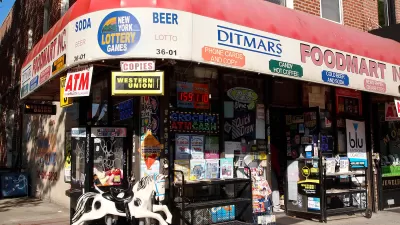The spatial needs of commerce and employment are shifting, and cities need to focus on bringing employment centers back to neighborhoods, argues Jay Hoekstra.
Writing for Terrain.org, Hoekstra argues that the urban form of cities and their employment centers will play a crucial role in luring and retaining residents, and therefore boosting the local economy.
"There should be more interaction between those who wish to attract the creative class and the new wave of urban design; and it is beginning. Indeed, more than a dozen years ago the James Irvine Foundation found that in this "new economy," firms are smaller: 55 percent of workers are employed by 100-person or smaller enterprises while 25 percent are employed by 100- to 500-person enterprises. Accordingly, smaller office and manufacturing buildings are needed. The Foundation's study noted that people have a "portfolio" of skills and move from job to job, to different types of work. Additionally, there are now more "craft" workers, more women integrating childcare and work, and more people working from home.
While there is a need for smaller workplaces, live/work venues, and work-at-home logistics, people still need the opportunity for "third place" meetings-a corner café, a local bookstore, a community garden even-within a socially and culturally rich landscape.
FULL STORY: Walking to Work

Alabama: Trump Terminates Settlements for Black Communities Harmed By Raw Sewage
Trump deemed the landmark civil rights agreement “illegal DEI and environmental justice policy.”

Planetizen Federal Action Tracker
A weekly monitor of how Trump’s orders and actions are impacting planners and planning in America.

The 120 Year Old Tiny Home Villages That Sheltered San Francisco’s Earthquake Refugees
More than a century ago, San Francisco mobilized to house thousands of residents displaced by the 1906 earthquake. Could their strategy offer a model for the present?

In Both Crashes and Crime, Public Transportation is Far Safer than Driving
Contrary to popular assumptions, public transportation has far lower crash and crime rates than automobile travel. For safer communities, improve and encourage transit travel.

Report: Zoning Reforms Should Complement Nashville’s Ambitious Transit Plan
Without reform, restrictive zoning codes will limit the impact of the city’s planned transit expansion and could exclude some of the residents who depend on transit the most.

Judge Orders Release of Frozen IRA, IIJA Funding
The decision is a victory for environmental groups who charged that freezing funds for critical infrastructure and disaster response programs caused “real and irreparable harm” to communities.
Urban Design for Planners 1: Software Tools
This six-course series explores essential urban design concepts using open source software and equips planners with the tools they need to participate fully in the urban design process.
Planning for Universal Design
Learn the tools for implementing Universal Design in planning regulations.
Clanton & Associates, Inc.
Jessamine County Fiscal Court
Institute for Housing and Urban Development Studies (IHS)
City of Grandview
Harvard GSD Executive Education
Toledo-Lucas County Plan Commissions
Salt Lake City
NYU Wagner Graduate School of Public Service





























